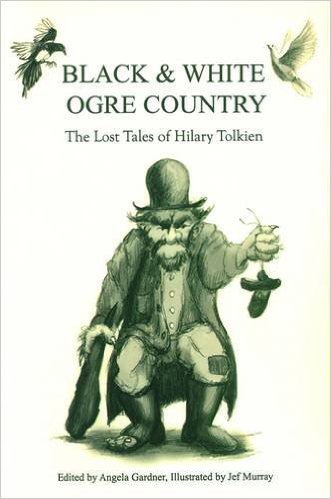Black & White Ogre Country

Black & White Ogre Country: The Lost Tales of Hilary Tolkien. Hilary Tolkien. Edited by Angela Gardner. Illustrated by Jef Murray. Moreton-in-Marsh, Great Britain: ADC Publications Ltd., 2009. ISBN 978-0-9551900-1-8. £9.99. (currently from $17.65 via Amazon)
Reviewed by Glen GoodKnight
[This review originally appeared in Mythlore 27.3/4 (#105/106) (2009): 167-68.]
The Golden Days Recalled
To my knowledge this is the first publication written by Hilary Tolkien. It was discovered in an attic box by Hilary’s grandson Chris Tolkien, who allowed it to be illustrated and published. The first third of the book was conceived when Ronald and Hilary were quite young. “Bumble Dell” describes both ogres, how they would treat Hilary if they caught him trespassing through their lands, and the delicious blackberry patch in a dell they called Bumble. It was later filled in by the Great Western Railway to get from Brum (Birmingham) to London quicker. It also describes two old mills, one of which was probably Sarehole mill.
This is followed by “Black and White Witches.” The Black Witch, who turned children into lumps of stone or took their sardine sandwiches, was poised again the Witch Witch, who when hearing of the Black Witch’s spells on children, ran off with her white cat and a dog to rescue them. She also ran a sweets shop, and sold sweets to children for “never more than a penny for a conical bag” (19).
The next part is about a rustic park run by Mr. Heaven and his daughter Helen Heaven. He would become furious when boys asked him “How is Hell in Heaven, Mr. H?” (22) and chased them around the lake until they reached where the swans were nesting, which then proceed to take nips out of their pants.
This is followed by Hilary’s first memories in 1899 or 1900 of seeing automobiles, which were constantly breaking down on the road. Hilary then recalls how, a few years later, the family went to another town for Sunday Mass, and he was allowed to drive the pony-pulled buggy part of the way. He recalls the owner, Mrs. Church, and her grouchy Crimean War veteran husband. Hilary then remembers the big sycamore where he and Ronald had picnics, and a neighbor’s dog who loved to dig into rabbit holes, so that only his tail showed.
Hilary then jumps forward for a brief memory of serving in World War I. Then he rambles about the farm animals he knew. He goes on further about a ghost he did not meet, and concludes with more memories of World Wars I and II. This is followed by a glossary of unfamiliar terms in the stories.
Then comes what is for me, the best part of the book: “A Brief Biography of Hilary Tolkien.” This includes eleven photos showing the two brothers as a very young age, a well done drawing of Mabel Tolkien, their mother, a photo of Hilary home from the War, photos of Hilary and his wife Magdalen, a colorful drawing of a cottage by Hilary, a color photo of Ronald and Hilary, and a photo taken in 1955 showing some members of both families together. The text of the biography is well written, with many hitherto unknown details about Hilary and his family. It is worth reading the book just for this part. The book discloses that it is the first chapter of a larger project to write a full biography of Hilary, including his drawings, photos and recently discovered letters between various members of the Tolkien and Suffield families.
This book shows that the two brothers, Ronald and Hilary, had several common interests. Both were interested in the care of plants: Hilary was a seller to local greengrocers, and also had a fruit orchard; Ronald did volunteer gardening for his local Catholic parish. They both enjoyed music: Hilary singing in his local parish choir; Ronald wrote words to already existing folk songs in Songs for the Philologists, and put his verse to music in “Namárië,” with the sound of a Latin Chant. They both enjoyed drawing: Hilary often drew pictures on cards as gifts (one is printed in this book), Ronald is well known for his drawings and paintings related to The Hobbit and The Lord of the Rings. These and other qualities it seems were passed on to them by their mother Mabel, who was “sainted” in their eyes, and was taken from them when she passed away when they were only ten and eight years old. They shared this grief in common.
After Hilary’s death in 1976, Ronald’s son Christopher wrote to Hilary’s son Gabriel: “So many of the very happiest of my own childhood memories are at Blackminster, and of the love and kindness we received from your parents; golden days they seem now, and I believe they really were” (73).
Black & White Ogre Country: The Lost Tales of Hilary Tolkien. Hilary Tolkien. Edited by Angela Gardner. Illustrated by Jef Murray. Moreton-in-Marsh, Great Britain: ADC Publications Ltd., 2009. ISBN 978-0-9551900-1-8. £9.99. (currently from $17.65 via Amazon)

